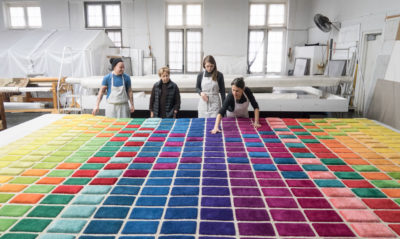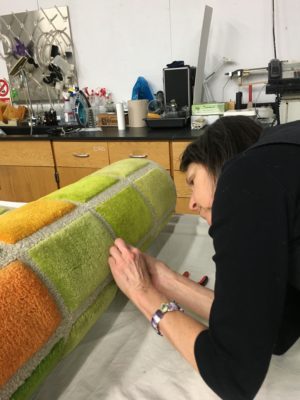 For years, a colorful work of fiber art by former Textile Design faculty member Wilma Grayson hung in the lobby of FIT’s Pomerantz Center. The design, a grid of colored rectangles on a white ground, was selected in 1975 by FIT’s Art Committee (and approved by the Art Commission of the City of New York) for manufacture by Edward Fields Carpet Makers. Grayson’s name, and the manufacturer’s initials, were incorporated into the piece. In spring 2017, when the college began renovating the lobby for an expansion, the piece was removed and sent to the Textile Conservation Lab at the Cathedral of Saint John the Divine. There experts undertook a careful cleaning. Members of the FIT community were involved in every step of the process.
For years, a colorful work of fiber art by former Textile Design faculty member Wilma Grayson hung in the lobby of FIT’s Pomerantz Center. The design, a grid of colored rectangles on a white ground, was selected in 1975 by FIT’s Art Committee (and approved by the Art Commission of the City of New York) for manufacture by Edward Fields Carpet Makers. Grayson’s name, and the manufacturer’s initials, were incorporated into the piece. In spring 2017, when the college began renovating the lobby for an expansion, the piece was removed and sent to the Textile Conservation Lab at the Cathedral of Saint John the Divine. There experts undertook a careful cleaning. Members of the FIT community were involved in every step of the process.

The lab’s director, Marlene Eidelheit, Museum Studies: Costume and Textiles ’88, said the piece had to be cleaned carefully because some of the dyes in the colored wool rectangles were “fugitive”—vulnerable to fading. Individual wicking cloths were placed over the rectangles to protect them. Foam cleaner was applied, then vacuumed off, said senior textile conservator Valerie Soll, who teaches costume collections management and conservation theory and practice in FIT’s School of Graduate Studies. The white ground was cleaned in a similar way—with swabs and gauze. Two alumni of the program assisted on the project—Jamie Casbon ’12, and Marina Kastan Hays ’17, who is now a Polaire Weissman Conservation Fellow at the Metropolitan Museum of Art’s Costume Institute. Current students Kaelyn Garcia and Meredith Menache, both ’18, worked on the piece as interns.
In February, the work was returned and was installed in a new location: the stairwell of the Katie Murphy Amphitheatre. “It was pretty dirty,” Soll said. “Hopefully it will be noticeably brighter now.” Remarkably, the 10-by-15 foot artwork, which weighs about 170 pounds, had been held in place by a mere two-inch strip of Velcro, which was glued all along the top. It now has 6 inches of Velcro, all sewn to a header (a long piece of fabric) on the back to distribute the weight.
